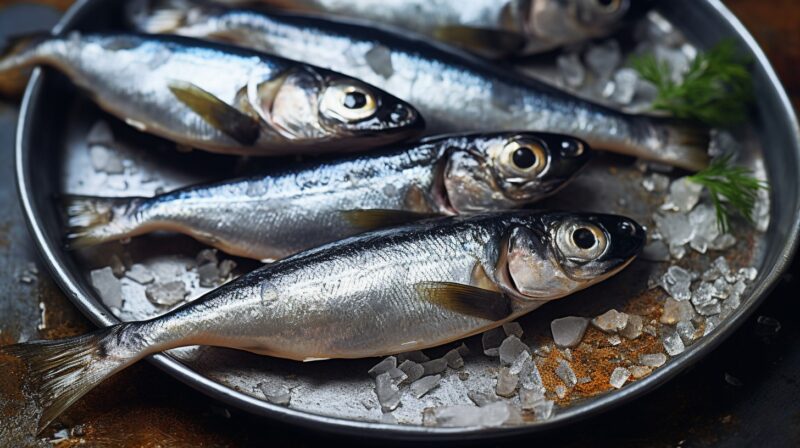
The consumption of sardines, small pelagic fish from the herring family, is widespread due to their nutritional benefits and culinary versatility. A common query that arises among consumers pertains to the edibility of their bones.
While many cultures incorporate whole sardines into their dishes, others express reservations about the potential health implications or palatability of consuming the bones.
At first, I didn’t understand why this was relevant, except when someone preferred it or not. What’s important to know is that they are edible, but this is only a part of the answer.
Drawing from scientific literature, nutritional data, and culinary practices, we will provide a clear and objective assessment of the matter.
Table of Contents
ToggleThe Anatomy
To grasp the feasibility of consuming sardine bones, one must first understand the fish’s unique structure. Often seen swimming in schools, sardines are small, oily fish belonging to the herring family. Shimmering silvery scales coat their streamlined bodies, making them glisten underwater.
They range between 6-12 inches, they’re lightweight, attributed to their swift movement. What differentiates sardines from many other fish is the composition of their bones. These fish have a skeletal system characterized by thin, malleable bones.
Due to their minimal thickness and tenderness, these bones are easily dissolved when subjected to cooking. As we’ve said, this is not a problem at all. In fact, it can even an additional taste to the dish.
The Nutritional Aspect

Choosing to eat sardine bones isn’t just about feasibility; there’s a nutrition angle that’s equally compelling. One of the standout nutrients in sardine bones is calcium.
- Bone and Teeth Fortification: Consuming these bones can significantly contribute to strengthening our skeletal system.
- Prevention: It plays a role in warding off osteoporosis and ensuring healthy bone density.
A Medley of Essential Nutrients
Sardine bones are a cocktail of nutrients beneficial for human health.
- Phosphorus and Magnesium: Working in tandem with calcium, phosphorus aids bone health, while magnesium caters to muscle function and energy synthesis.
- Omega-3 Fatty Acids: Surprisingly, even the bones have traces of omega-3s, pivotal for cardiovascular health.
Their Place in the Culinary Universe
Preparation methods influence the texture and taste of these bones, determining their edibility. Certain culinary processes can make the bones not just edible but enjoyable. Direct exposure to high heat makes the bones crispy, lending a crunchy texture.
Sardines preserved in cans usually have bones that are soft, almost gelatinous, due to prolonged exposure to heat and preservatives. There’s an ongoing discussion in the culinary realm about whether to keep or remove the bones.
Deboning them provides a smoother texture, catering to those wary of bones, while eating the fish in its entirety ensures a richer flavor and maximizes nutrient intake.

Addressing Concerns
It’s essential to separate facts from myths to make informed decisions. Safety concerns, especially related to digestion and choking, often arise. Given their tender nature, sardine bones present a minimal choking hazard. Unlike harder bones, these are easily broken down during digestion, causing no harm.
A misconception exists that bones might negatively influence the sardine’s taste.
- True Flavor Profile: The bones, if anything, add depth to the sardine’s umami richness.
- Texture Talk: While they introduce a nuanced crunch, it harmoniously contrasts the soft flesh of the fish.
Global Gastronomy
Worldwide, many cultures have embraced and celebrated sardine bones in their culinary practices.
Asian Culinary Chronicles
Across Asia, sardines are frequently consumed, bones and all.
- Japan’s Grilled Delights: They are grilled to perfection, with bones offering a crunchy juxtaposition.
- Filipino Soupy Affair: The Philippines sees them stewed in tamarind, where bones soften, merging with the broth.
Mediterranean Culinary Canvas
The Mediterranean, with its vast coastline, has a special relationship with sardines.
- Portuguese Festive Feasts: Grilled, consumed whole, are a highlight of many Portuguese festivals.
- Italian Pasta Integration: Sardines, bones included, are often integrated into pasta dishes, complementing the robust flavors.
It is a Personal Choice
While information is power, individual preferences and health play a pivotal role in the decision to consume sardine bones. It’s vital to ensure that your health aligns with your dietary choices.
- Allergy Concerns: Some individuals might display allergic reactions or sensitivities to certain components of fish bones.
- Digestive Health: For those with specific gastrointestinal conditions, it’s prudent to consult a healthcare professional before making sardine bones a regular part of their diet.
Beyond health, personal taste preferences greatly influence food choices. If you’re on the fence, sample both bone-in and boneless preparations to determine which resonates with your palate. Those with a penchant for trying new textures and flavors might relish the unique experience sardine bones offer.
FAQs
I’ve bought canned sardines. Do they still have bones?
Many canned ones do contain bones, but they are typically softened due to the canning process, making them even easier to consume. There are boneless options available too.
I have digestive issues. Should I avoid eating sardine bones?
If you have specific gastrointestinal conditions or concerns, it’s always best to consult with a healthcare professional before regularly consuming them with bones.
Can kids eat sardine bones too?
Yes, but always under supervision. Due to the soft nature of the bones, they are generally safe, but it’s always best to be cautious with younger children.
From an ecological standpoint, is eating the whole sardine, bones and all, more sustainable?
Consuming the entire fish minimizes waste and supports a holistic approach to seafood consumption. Plus, they are a sustainable fish choice due to their rapid breeding.
How do bone-in fare in terms of shelf life compared to boneless?
The presence of bones doesn’t significantly impact the shelf life. Proper storage and adherence to expiry dates are more critical factors.
Wrapping Up
Alright, after taking this tour through the sardine world and really getting into the nitty-gritty of those bones, I’ve honestly broadened my views. I mean, who knew such a small fish could stir up so much curiosity and passion?
From the tiny details of their anatomy to the global kitchen practices and health perks, it’s been quite the learning curve. It just goes to show, food isn’t just about filling our bellies; it’s about stories, traditions, and sometimes, a bit of debate.
And as for those sardine bones? Well, to eat or not to eat, I say – whatever floats your boat!
Related Posts:
- When Can Kids Eat Popcorn? A Parent's Guide to Safe Snacking
- Do Anchovies Have Bones: Bony Business
- Can You Make Meatloaf Without Eggs? - Yes, you can!
- How Many Calories in a Can of Sardines: Inside the Can
- Can You Freeze Chicken Salad? - Preserving Freshness
- Can You Freeze Scrambled Eggs? Discover How to Do It



















